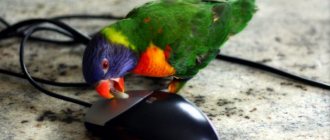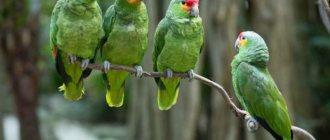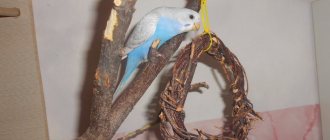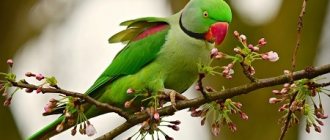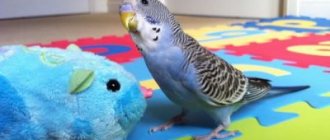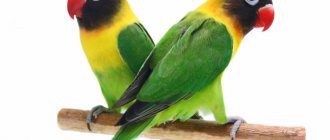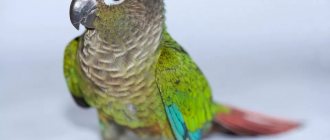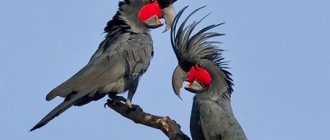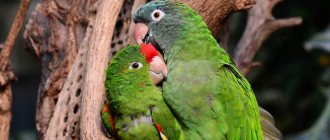Today, the variety of birds in pet stores and pet markets can be dizzying. And, for example, instead of choosing the easiest budgie to care for and maintain, you will buy a cockatoo, which will most likely turn out to be torture and will not bring the expected joy. We learn by starting with the simple and gradually moving on to the complex. This should also be applied to choosing a pet, in particular a parrot. If you cannot overcome the irresistible desire to buy a large parrot - a cockatoo or a macaw, then you will have to thoroughly study the literature about these types of birds, talk with owners who have sufficient experience, and perhaps even turn to a professional trainer.
What kind of parrot to have at home
There are about three hundred species of parrots in nature.
The most popular feathered pet today is the budgerigar. This small, sociable bird with a cheerful disposition will become a true friend to both adults and children in the family. The budgerigar is quite unpretentious and easily tamed. A little patience and diligence, and this funny creature will begin to repeat words after a person and imitate melodic sounds. Budgerigars can learn up to 100 words. They can be kept alone, in pairs or even in whole flocks. But if you want your pet to talk, then it is better to buy one. The wavy will not require much of the owner’s time, and remaining in splendid isolation, will not experience discomfort due to lack of attention. Budgerigars, lovebirds, and songbirds are small species of parrots. There are also medium-sized types of parrots: cockatiels, rosellas, ring-necked parrots, and large ones: macaws, cockatoos and others. This, as a rule, is a true friend bird, a companion bird, but caring for such birds is much more difficult than for small species.
Recently, medium-sized parrots – Amazons and Grays – have become very popular among those wishing to have a feathered friend. These birds are easier to care for, they speak well, are quite easy to tame and quickly get used to a new family and unfamiliar surroundings. The only thing that distinguishes them from other species of birds is the requirement for increased attention to their person. Lack of attention can lead to diseases, more often neuroses, which manifest themselves in the form of plucking their own feathers. You need to communicate a lot with them. The gray parrot (jaco) is considered by many to be the most gifted - it grasps everything on the fly and very soon begins to repeat words and entire sentences after a person. They quickly become attached to their owner, but unlike the Amazons, they are jealous and vindictive.
Unlike large parrots, lovebirds do not take up much space and do not require a huge, expensive cage. But if you want to keep a lovebird alone (without a mate), then you need to take it at a very young age. It is very difficult to tame and raise an adult lovebird, and keeping an untamed bird alone is bad for your pet. Unlike budgies, which do not suffer from loneliness provided that the owner devotes enough time to them, lovebirds prefer to live in pairs.
Corella also does not require huge premises and will quickly become everyone's favorite. He is easily tamed, sits on your hand, shoulder, and eats from your hand. Cockatiels do not have the same ability to imitate human speech as, for example, Grays, but they are quite capable of learning several dozen words (with the proper patience and perseverance of the owner).
Keep in mind that a child should never have large parrots! Such birds occupy a certain hierarchy in the family, considering it their flock, and sometimes they try to take a leading role in it, which can even be fraught with serious injuries for a child.
You should also take into account that in most cases a parrot is a restless bird: you and your household will have to get used to its loud screams! An exception to this can be considered pink-bellied parrots. They are called “living pictures”: they are considered to be very suitable as pets for busy people.
If you decide to have a bird as a pet, then you should understand that you are taking responsibility for a living creature, acquiring a new friend who, if properly maintained, can live in your family for decades. In addition to the joy of communicating with an exotic pet, be it small or large, you may also encounter a number of problems.
Benefits - what does a bird give to a person?
In addition to their attractive appearance and pleasant chirping, budgies have a lot of positive aspects compared to other pets, such as cats, dogs or fish.
Conversations
Parrots can imitate human speech. Many individuals are able to reproduce a simple melody of a song or the sounds of household appliances.
If you regularly work with your bird, it will learn to pronounce not only individual phrases, but also entire sentences.
Budgerigars can remember up to 100 words. The best results can be achieved with an individual living alone. Due to lack of communication, the bird will happily make contact with a person.
Is it worth getting a parrot?
Not really
Attachment
Almost all parrots, including budgerigars, avoid loneliness . In the absence of a play partner, the pet develops depression, which will result in fallen feathers. The bird quickly gets used to the person and expresses its affection in different forms: it gets bored in his absence, rejoices when he is nearby.
In a word, a budgie is a faithful friend, like a dog or cat, capable of giving many pleasant moments.
It is also useful to read: Choosing a pair for a budgie
Ease of keeping in an apartment
The bird's cage needs to be cleaned periodically, which is not difficult at all. The same dogs need to be walked, and the litter box needs to be cleaned after the cat every day. The pet takes care of its body itself : plucks out excess feathers, removes lumps, etc.
Food for budgies costs pennies. Due to its small size, during the molting period it requires a tiny portion of fruits and vegetables. This is a self-sufficient bird and cannot be called picky.
Quick wits
By spending the energy to train your pet, you will get not just an attractive exotic animal, but a smart play partner.
Parrots can analyze and at the same time reason logically at a basic level: determine color, understand the concepts of “more” and “less.” Particularly talented individuals are able to conduct a dialogue - ask and answer questions.
What you need to know before getting a parrot at home
Firstly, you need to know that birds, like other animals, are susceptible to various diseases. And among these pathologies there are a number of diseases common to humans. The first thing that should cause concern is ornithosis (psittacosis), an infection transmitted to humans
To prevent infection with this disease, first of all, you need to buy a parrot from a trusted place (in a pet store or from a breeder with a good reputation), and also pay attention to its health status when purchasing. A healthy bird has good plumage and shiny eyes
In addition, the parrot must be quite active and energetic. Sneezing, diarrhea, refusal to feed, discharge from the eyes or beak, depression should alert the buyer, and if such symptoms are observed in a bird already living at home, you should immediately contact a veterinary clinic.
Parasitic diseases are also widespread in birds. The most common are knemidocoptic mange (bird mite), in which whitish-gray spongy growths around the beak and on the legs are observed, and mallophagosis (feather-eaters), accompanied by restlessness, itching, and partial loss of plumage. Helminthiases are also possible in birds.
In addition, parrots suffer from nutritional diseases associated with improper feeding. To prevent them, it is necessary to ensure that the bird’s diet is varied, and to avoid sudden changes in feed or feeding with poor-quality feed.
Diseases in parrots develop very quickly, so the owner of the bird should immediately contact an ornithologist if symptoms such as apathy, refusal to feed, diarrhea, discharge from the eyes or beak, or ruffled plumage appear. In addition, it is advisable to visit a doctor immediately after purchase to get advice on feeding and maintenance, as well as to conduct an initial examination of the bird.
Diet
Budgerigars have a varied diet. A balanced complex of nutrients and active substances will help you be completely healthy. Birds should be fed with special food from a pet store, but first the owner can consult with an ornithologist to choose a suitable grain mixture.
In addition to grain, birds should be given vitamins, which they can get from vegetables, fruits, cereals, herbs and nuts. Also, the bird’s body must receive macro and microelements, which should be given separately from complementary foods.
Prohibited Products
Everything that the owner eats will not suit the budgerigar’s diet. You should absolutely not give them caffeine, alcohol or cocoa. This is deadly for the life of the pet. You should also not give baked goods, because the yeast will swell inside the stomach and cause gastrointestinal upset. In addition to these foods, pets should not eat fried, sweet or spicy foods. You can replace all this with a boiled chicken egg, just cook without adding salt.
If the owner decides to pamper the pet with berries or fruits containing a seed, then it must be removed, because... under the influence of moisture, hydrocyanic acid is formed, the consumption of which will also cause food poisoning.
Favorite Products
Budgerigars are not picky eaters, so you can give them what you like. Fruits and vegetables containing vitamins A and B, as well as boiled nuts and cereals. Budgerigars love to crunch, so the owner can safely eat an apple, carrots, cabbage and crackers made from whole grain bran without salt.
Differences between male and female budgerigars
Usually, male and female budgerigars are distinguished by the color of the growth at the base of the beak - the cere. In the male, this growth is light purple (in young birds) or bright blue (in an adult). In a small female, the cere has a light blue tint, in a mature female it is light brown, dark brown or light gray.
The girl has an unusual spot on her forehead that glows under the influence of ultraviolet rays. Ornithologists believe this attracts males.
Unusual ways
If you have no idea how to teach a parrot to sit on your hand, try an unconventional teaching method. To do this, it is enough to trim the flight feathers on the wings. The bird will not be able to fly and will be forced to sit on the palm. But after the feathers grow, there is no guarantee that the bird will be tamed.
There is another recommendation that allows you to train a parrot in just a few days. Place both palms into the cage at once and keep them there. When the pet gets tired of fluttering, he will climb into your arms. On the fourth day of such experiments, the bird gets used to its new owner. But this method is not suitable for everyone, as it puts a strong strain on the psyche. The parrot will sit on your hands, but will still be afraid.
When taming a pet, do not wave your hands over its head. This is due to the fact that they have a reflex that a flicker from above is the shadow of a bird of prey. As a result, an association will arise: hand – danger. It will be impossible to retrain the bird.
Training is a rather lengthy process. Some wavy animals become tamed only at one year of age. You cannot punish a bird if it bites. This is an adequate reaction to an invasion of personal space. Or the pet is defending itself. In such a situation, try to calm the parrot in an even voice or move away from him. After some time, the procedure can be repeated.
You should not lure the bird with treats when it is just starting to leave its cage. In addition, you should not grab it suddenly. The purpose of taming is to make the pet not afraid of your palms. If you do everything right, you can quickly win the love and trust of your feathered friend.
Some of the most amazing pets are parrots. At first glance, it may seem that this is a primitive noisy bird. But that's not true. Or rather, this is true if the parrot is not tamed and trained. Of course, a wild parrot is nothing but trouble - as soon as the owner approaches the cage, the bird begins to scream and rush around, blowing its feathers all over the apartment. But a trained tame bird gives only positive emotions.
Price for a budgerigar in rubles
The price for a feathered pet varies from approximately 500 to 1,500 rubles, depending on the age of the bird and its unique color. Knowing everything about budgies, you can safely get a cheerful, energetic bird. And with a little effort, attention, affection and care, you will receive in return the love and affection of your feathered friend.
Read the article on social networks, subscribe to site updates, leave comments. Goodbye.
More materials about pets
Did you like the article? Not good? Then it is possible that you will write yours much better. Just follow the link Posting articles and read the rules for publishing articles on the MultiBlog67.RU website.
Conditions for reproduction
It is advisable for a breeder who decides to breed budgerigars to have several pairs. This will allow, in case of possible problems with the chicks or clutch, to save the offspring and preserve the health of the adults.
Right to breed
Breeding budgerigars at home is not regulated by law; anyone can do it. But to officially register his activities, the breeder must have a license, which is issued by the Society of Bird Lovers. A person needs to confirm that he has knowledge about the breeding and maintenance of budgerigars.
It is the responsibility of veterinarians to check birds for psittacosis. This viral infection can infect not only animals and birds, but also humans. If the test does not reveal this disease, the owner receives official permission for breeding. He is given permanent rings containing information about the breeder, the serial number of his bird, the date and time of registration. During disease outbreaks, this makes it easier to track the location of parrots.
Choosing the right pair
To get healthy offspring, you need to organize the correct selection of a pair of wavy birds. They must be from different parents to prevent the development of genetic diseases in the chicks. How to understand that a male and a female are suitable for each other?
Both parrots should be healthy, active and well-fed. Weak or elderly birds often lay unfertilized eggs. Puberty of females occurs in the second year of life. In males, this period begins a little earlier, from ten months of age. The peak of fertility in wavy birds is observed at the age of 2–4 years. Although parrots breed up to 10 years old.
You might be interested in: Where do parrots live: habitat of popular species of parrots
This is interesting! A budgerigar remains attached to its partner for life. Without mutual sympathy, reproduction does not occur.
Suitable period for breeding
The optimal time for breeding wavy plants at home is the summer months, from June to September. This is the part of the year when parrots get enough sunlight and vitamins. In other periods, they may be weakened due to a deficiency of substances necessary for the body. And this can affect the health of the offspring.
If breeding of parrots is planned for the winter or spring months, the birds must be provided with enhanced nutrition with fresh herbs. At least 14 hours of daylight are required; illumination with a special lamp is allowed. The air temperature must be at least 23 degrees.
Parrot mating process
What conditions need to be created
In addition to selecting a pair, the breeder should think about creating conditions for reproduction. To do this, you need to choose a cage that is suitable in size for the birds. The size of the housing for one pair of wavy plants is 80 cm in length, 40 cm in height and 35 cm in width. If one cell contains several pairs, then these dimensions should be larger.
Females need houses with nests where they can hatch their offspring. When the parrot begins to lay eggs, the cage is placed in a quiet corner so that the bird is not disturbed. The room temperature must be maintained at least 20 degrees. At the same time, heat and stuffiness should not be allowed, as this poses a threat to the embryos.
Feeding parrots during the breeding season
The budgerigar's menu includes grains and seeds, as well as fruits and vegetables.
To stimulate the sexual instinct, the diet should contain the following foods:
- low-fat cottage cheese;
- greenery;
- sprouted grains;
- egg white;
- special mineral supplements.
When a female parrot lays eggs, she requires an increased diet. Products high in vitamin E are very useful. Experienced breeders advise feeding their pets a mixture of cottage cheese, eggs, carrots and sprouted grains.
You might be interested in: How to choose a budgie: preparation, choice of bird, adaptation
It is important to know! Obese or underweight birds are not suitable for breeding. The pair must be fattened before breeding, but not excessively
Feeding parrots at home
What the “Australian guest” is fed at home largely determines his health, well-being and life expectancy. The menu of the winged household should be varied. Suitable cereals (oats, millet, buckwheat, millet), sunflower seeds.
Sometimes you can treat him with legumes boiled until fully cooked. In winter, cottage cheese and a hard-boiled egg, but completely cooled, are recommended. You can use live food rich in protein (bugs, larvae, moths). Apples, carrots, and pumpkin can also be included in your pet’s diet if they are grated on a fine grater.
In summer, you can add salad leaves and dandelion leaves to your diet. In winter, it is recommended to add lemon juice to water to strengthen the immune system. During molting or illness, vitamins are desirable.
It is strictly forbidden to give parrots meat, fatty, salty and sweet foods. You should not overfeed your pet to avoid obesity.
We are responsible for those we have tamed
Sooner or later, every parent asks the question: is it worth buying a parrot when there is a child in the house? It is precisely this formulation of the question that implies an understanding of what responsibility for the bird “will fall on the shoulders” of the parent, and then the child.
The parents’ task is to explain to the child that having a pet is not only about games, but also about daily care for the well-being and health of the bird. That with the appearance of a parrot in the house, responsibilities will appear and you will need to bear responsibility for the life of a small and defenseless creature.
Photo: Arthur T. LaBar
Tell your child what needs to be done, and after purchasing a parrot, show with your example how to behave with the bird and what actions are acceptable for the successful adaptation of a new friend.
Study the requirements for keeping a bird and prepare in advance for its appearance in the house. Explain to your child what actions are harmful to the bird, what needs to be done to tame a parrot.
This is a responsible step and the decision to buy a parrot should be made consciously and with the consent of all family members.
If the child is five years old or younger, share the care of the bird with him and allow him to take part in walking the bird and cleaning its cage.
Caring for a parrot and making friends with it have a positive impact on the child, instilling in him responsibility for the life of his little friend and forming a further attitude towards other animals and people.
Photo: rebloggy
A tamed bird that is not afraid of its little owners and thanks to them can talk or perform various tricks is the pride of a child and a vivid example that a parrot can become a true friend for a child.
Content Features
A pair of budgies in one cage requires additional attention and care from the owner, so it is important to follow a number of rules in relation to the cage and feeder for keeping two parrots
Cell
Budgerigars are not picky about their habitat, so you should follow only a few simple rules in
The cage must accommodate two birds with their wings fully extended, because they jump from branch to branch with the help of their wings. Otherwise, they may damage their wings on the bars.
The approximate dimensions of the cage should be within 60x30x40 cm, but you need to take into account the individual characteristics of the pet, because a budgerigar can be a large individual and then the indicated dimensions will not be enough. Ideally, measure the length of the bird's wings and the width of the bird's body to get a complete idea of the comfortable size of the cage.
The shape of the cage should be rectangular with a semicircular roof. It is very difficult for a parrot to navigate in cylindrical, cone-shaped, round or shaped cages
Attention should also be paid to the gaps between the rods. They should be without points or protrusions, so as not to damage the birds’ legs.
In addition, horizontal bars allow the parrot to move freely around the cage using not only the floor and branches, but also the walls.
Budgerigars strive to be close to their owner, so you need to be prepared for escape attempts.
To prevent this and avoid injury, the gap between the bars should be at least 1-1.5 cm. In this situation, the budgerigars will physically not be able to insert anything other than their beak into the gap.
If we are talking about the beak, then it is worth talking about the material used to make the cage. Living in pairs, birds like to take turns eating, but in the process they “chew” the twigs.
Ornithologists say that this is one of the ways birds communicate with their owner, because the beak is activated, accompanied by a characteristic sound. It follows from this that grids made of galvanized metals (lead, zinc, copper) are strictly contraindicated.
Feeder
Budgerigars need to be fed from several feeders, which is dictated by their diet. So, you need to stock up on at least two containers: one for grain, the other for mineral delicacies. Birds are very picky creatures, so ornithologists do not recommend mixing different foods in one bowl, so it is ideal to have a third feeder for all other types of food.
Parrots may have conflicts if they eat from the same feeder and drink from the same water bowl. The optimal solution is to purchase a special large bowl for feeding parrots, which can comfortably accommodate both pets
An automatic drinking bowl is used for a pair of parrots. This is due to the fact that, being in the same cage, a couple can play with each other, which often leads to overflowing a regular drinking bowl.
Bird character
The bird is characterized by great mobility, noisy and loud behavior. In nature, they actively search for food until noon, then fly in flocks in search of life-giving moisture. At lunchtime they relax in the shade of tropical trees. They flutter swiftly and quickly, often flapping their wings. It walks along the ground slowly, like a bear, waddling from foot to foot.
Character of the necklace parrotA feature of the Indian ringed is their good nature and cheerful disposition. Among people he adapts quite quickly. The bird is intellectually developed. Has the ability to imitate human speech and reproduce the sounds of other animals. They remember melodies well. Although it should be noted that this talent is not as developed as in other species of parrots.
How to determine the sex of a necklace parrot
Parrots have no hair
Instead of fur like dogs or cats, parrots have “powder.” These are tiny horny particles of down feathers that resemble talc in properties and are needed to repel water if the bird gets wet. But certain species of parrots (Eclectus are one of them) do not produce any powder, but have sebaceous glands. Such birds are suitable even for those who are allergic to feathers.
In addition, parrots are not as odorous as other animals. A healthy, well-groomed bird smells like honey or sun-dried feathers.
Disadvantages of keeping parrots
There are also disadvantages to keeping parrots at home:
Noise. This is the main disadvantage of a parrot. Parrots are very sociable and active birds. During daylight hours, they constantly scream, rattle toys and bowls, climb noisily and fly around the cage. If the cage is not covered with a dark cloth at night, the bird will wake up at sunrise and begin to make noise. The screams of parrots, especially large species, are very loud and can disturb not only the owners, but also the neighbors in an apartment building. Dirt. This is also a big disadvantage of parrots. These birds are not known for their neatness, so there will always be feathers, leftover food and droppings scattered around the cage. During walks, the bird will also leave droppings and feathers everywhere. In many species, the skin produces a special powder that birds use to treat their plumage. In the room where the cage is, everything will be covered with a layer of this powder. Therefore, the room will have to be cleaned daily. Destructiveness. These birds have a powerful and sharp beak and great strength. During walks, they will chew furniture, tear curtains and wallpaper, and dig soil in flower pots. The cage must be strong, otherwise the bird will bend the bars or learn to open the door and get out of its own free will. Inability to leave your pet alone for a long time. Birds have a fast metabolism, so they cannot go long without food and water. You need to add food and change water daily or even twice a day. Therefore, if owners need to leave for a long time, they will have to look for someone who will take care of the animal. The need to pay a lot of attention to your pet. Parrots need to constantly communicate with relatives or people
Without communication, they experience stress, begin to pluck their own feathers, refuse to feed, become lethargic, and attract attention with loud screams. Cellular content. Along with the advantages of cellular maintenance, there are also disadvantages
The cage takes up quite a lot of space, so it is necessary to allocate a separate space in the room where it will stand. The cage tray gets dirty quickly and needs daily cleaning. In addition, the entire cage and accessories should be washed regularly. Possible health problems for the owner. Some people develop allergies to bird waste or feed. Birds bought from a pet store or poultry market can cause psittacosis, salmonellosis, campylobacteriosis and chlamydia. Large parrots bite painfully and, if frightened, can cause serious injuries to humans with their beaks and claws.
Negative aspects of the content
Like any other pet, budgies have their downsides. They need to be weighed before purchasing the bird. In addition, for some, the disadvantages can be critical.
Allergy
Any bird is down and feathers. The budgerigar is no exception. The best option is to have allergy tests done by a specialist. If your friends have a bird, you can take it in for a while to determine the attitude of household members towards down and feathers.
Garbage
Food, droppings and husks scatter about a meter from the pet’s home. That is, in addition to cleaning the cage itself, you will have to clean the surrounding area. And these may be household appliances, furniture cracks and other hard-to-reach places.
Sounds
Budgerigars are quite noisy animals.
They constantly chatter, coo and chirp, especially if they are in company. Throwing fabric over the cage, as is the case with larger specimens, does not help here. If you are not ready to get up with them at six in the morning, then it is better not to have such pets.
Although with rare exceptions, some birds get psittacosis. This infection is transmitted to humans. In this case, the owner will have to seek help from both a veterinarian and a clinic.
Space
The bird needs walks. At least once a day, the pet should fly freely around the room. Given the playful nature of budgies, they can begin to “play” with expensive furniture and appliances, gnawing cords, picking off embossing, and also damaging flowers.
What influences the decision whether to buy a feathered pet or not?
First, you need to organize comfortable conditions for your future pet. In the absence of the latter, the bird will often get sick, which is expressed in an unhealthy appearance and lack of interest in what is happening around it. If the owner cannot provide the pet with a good cage, food and microclimate, then it is not worth getting a bird .
When choosing a bird, you should give preference to active individuals - vocal and with bright plumage. Passive and sleepy animals that show no interest in their surroundings are not the best option, especially for a beginner.
Cell
Some random place for a cage will not be suitable. The optimal solution is a bright room near the window. Both strong drafts that can chill the bird and heating appliances should be avoided. That is, everything that dramatically changes the microclimate in the room.
It is more practical to look for a cage with a retractable lower part , which will add convenience during maintenance. A drinking bowl with a feeder, as well as perches, must be placed inside. When a bird sits on a flat surface for a long time, its legs become deformed and at the same time weaken. It is better to take thicker perches and fasten them well, otherwise the pet will simply break them or chew them off.
If the parrot is alone, then it would be useful to install a small mirror in the cage, which will at least partially alleviate its loneliness. During the summer months, your pet will need a bath with clean water at room temperature. Approximately once a week it is necessary to carry out general cleaning of the cage.
Feed
In almost any pet store you can find a dry grain mixture for budgies. On average, a tablespoon of food is more than enough for one individual. The main component of such mixtures is millet, which has a beneficial effect on the animal’s gastrointestinal tract.
In addition to bulk feed, the bird should be given:
- porridge;
- boiled eggs;
- cottage cheese;
- grated fruits with vegetables: apples, carrots.
If the hassle of feeding and caring for a parrot is too much, then it is better to refuse to buy it and look towards less picky pets.
Microclimate
The optimal microclimate for poultry is a temperature of about +20⁰С and a humidity of about 70-80%. It’s not so scary if the thermometer drops below +15 or even +10⁰С. The pet is not afraid of low temperatures, but of sudden changes in the microclimate.
To prevent the parrot from grinding its beak on perches and twigs, it is necessary to place fresh twigs from bushes or trees around the cage , not forgetting to change them periodically.
If the temperature outside the window drops below 0⁰C during the winter months, then under no circumstances should you keep the bird on the balcony. In city apartments, the optimal place for a parrot is the kitchen, somewhere away from the stove and refrigerator.
Alone or in pairs - which is better?
The budgerigar is a flocking bird that cannot develop adequately without its relatives nearby.
Of course, the bird will greet its owner more joyfully and learn to speak faster, but this is all the result of sadness and sadness in moments of human absence.
Despite the seemingly external satisfaction from life and a cheerful mood, a lonely parrot will not receive what is inherent in it by nature. Even if you spend 24/7 with your pet, this is not enough, because... Bird communication is not just about actual presence or voice. This is also communication with body language, gestures, plumage, coloring.
In animals of the same species, even if there are only two of them, a certain hierarchical behavior is established: one of the parrots becomes a role model. In addition, in pairs, parrots can engage in procedures laid down by genes. This is something that cannot only be taught, but also unlearned.
As the owners of several birds say, monitoring and caring for a pair is much easier than for a single bird, because... in a group, parrots can occupy themselves and will not constantly call their owner across the entire apartment.
How many parrots do you have?
12
How to properly organize the life of animals in one house
It is almost impossible to predict in advance how a budgerigar's life together with other pets will turn out. Each animal has its own character, habits, needs and instincts, which can manifest themselves completely unexpectedly. You must always be careful and avoid dangerous situations.
Some tips to help make friends with pets:
If a cat or dog lives in the house, it is necessary to closely monitor their health and promptly get rid of fleas and parasites. This is especially true for rodents and reptiles: their parasites are unpleasant and dangerous for parrots. If the wavy dog begins to behave strangely, it needs to be shown to a veterinarian. It is recommended that cats have their nails trimmed to prevent them from accidentally injuring the parrot. You should not immediately try to make friends with a bird. The cage should be in an inaccessible place where a cat or dog cannot enter; the parrot should be released in an empty and closed room where there are no other animals. Even if budgies and cockatiels, finches or canaries get along well, you cannot leave them in the same cage forever. No matter how peacefully they sit next to each other, quarrels and fights are inevitable, especially at the beginning of acquaintance. They can end unpleasantly. Owners often compare pets to children: when something new appears, the “old” ones become jealous and may try to get rid of them. Owners are often to blame: they pay more attention to new ones, give more treats in front of the first ones.
It is necessary to pay equal attention to both pets so that the “old” ones do not feel deprived and do not harm the new ones. When getting a parrot, you must first keep it in quarantine in a separate room. Quarantine time is selected individually - from 7 to 40 days
Then you need to give him time to get used to the new room and only then introduce him to other pets. If during quarantine the bird looks bad and is sad, it should be taken to the veterinarian. Perhaps the problem is a lack of vitamins or a transition to a new diet, although usually the malaise is associated with a new place and goes away on its own. Budgerigars must live separately from other small birds, but cages can be placed nearby. Birds will talk and develop without interfering with each other. They can fly around the room together. You cannot punish an old pet for showing aggression towards a new resident. For a cat or dog living in an apartment, a parrot is an enemy to which owners pay more attention. An attack by a bird should not be encouraged, since it may decide that it is in charge and behave accordingly. You need to introduce pets gradually: first, let them into the room with the cage only under supervision and lock it when leaving, then you can leave the door open when someone remains in the apartment. This may take several days or weeks. The longer a cat or dog has lived alone, the longer it will take for them to get used to the bird. You need to show patience and endurance. If there are pets in aquariums and terrariums in the apartment, they must be securely closed. Wavys are curious and can fly into the water or towards a dangerous predator that does not know whether it has got food or a friend. When leaving the apartment, you need to lock the bird in a cage and put it in a safe place. Unfortunately, the hunter's instinct can awaken even in the most phlegmatic cat, which will lead to unpleasant consequences.
Main care questions
— Do parrots need to be vaccinated? “Parrots are not vaccinated by veterinarians,” says Oleg Rosenberg, a teacher at the veterinary and zoology club at the Minor Academy of Sciences. — If a bird lives in an outdoor enclosure and has contact with wild birds, then you need to buy a vaccine against Newcastle disease at the pharmacy. Take one dose and add it to the bird’s water. The vaccine should be given once a year. If the parrot lives in an apartment, no vaccine is needed.
In summer, expose the bird to direct sun every day for 20 minutes; this will help prevent rickets, which occurs due to a lack of vitamin D in the body.
— What to feed the birds? — Parrots are fed special food, which is sold in pet stores. As for treats, everything is individual, you need to try different options and see what your pet likes best. If we talk about small breeds, some love seeds, others millet and dried fruits, large breeds love walnuts and fruits.
For parrots that sit in cages for a long time, bring branches of fruit trees (cherries, plums) with buds that have not been treated with chemicals. Parrots will gnaw buds and bark and grind down their beak.
— What kind of water can I give? - Ordinary boiled.
— How much time should you devote to the bird? - At least an hour a day. If you have several birds, then you need to communicate with each of them separately. Parrots are social birds. If you don’t spend time with them, and only with them, without being distracted by anyone else in the family, your pet may get sick.
— Is it possible to get a parrot if there is already a cat at home? — If you let a small parrot fly, it will become a target for the cat. The exception is if they grew up together. In this case, the cat will perceive the same budgerigar as a home interior. The cat will not attack large parrots (Grey, Amazon), because they are large and can peck painfully.
— Do I need to bathe a parrot and how to care for them? - There is no need to forcefully bathe a parrot. Place the bathing suit in the cage, and when the bird wants, then he will take a bath. Birds need their claws trimmed. You can do this yourself at home. Buy a nail clipper (ordinary scissors will not work), and watch several video tutorials on the Internet. It clearly shows at what angle the claws should be trimmed.
— How to choose a cage? — The cage must be spacious so that the parrot can fly in it. It is necessary that at a minimum the bird can make 4 wing strokes from the perch (the place where it will sit) to the perch. In this case, the wing muscles will work well, and the parrot will be comfortable with you.
Large parrots, such as Grays and Amazons, need more space. An enclosure measuring approximately one meter by one meter from floor to ceiling will suit them.
— Should I let my parrot fly around the house? — A parrot shouldn’t fly around the apartment all the time. In 90% of cases, the death of these birds occurs due to the fact that they are released for a walk. Parrots do not navigate the terrain; when they fly out of the cage, they immediately get lost. If you still decide to let him out, close the windows in the room with curtains. Parrots often hit glass when they accelerate. In addition, the parrot can sit on the door, and if it closes due to a draft, the bird will pinch its paws - consider that you have lost it. Finally, your pet may fly into the kitchen, fall into boiling soup, or, out of curiosity, peck at salt, which is poison for birds.
Be prepared for the fact that parrots will try everything with their beaks: they will chew wallpaper, decorative elements, and wiring.
— What can scare a parrot? - Under no circumstances should you grab his paws without allowing him to move. The bird may die of fear. For a bird, flight is a normal, natural state. The parrot must feel that it can fly away from danger at any moment. If you immobilize him, adrenaline is released, and the heart cannot stand it.
If a parrot was flying and suddenly landed on your shoulder or scratched you, do not flinch. You can't shout or wave your arms. This is perceived as aggression and can frighten the pet.
Negative aspects of the content
Like any other pet, budgies have their downsides. They need to be weighed before purchasing the bird. In addition, for some, the disadvantages can be critical.
Allergy
Any bird is down and feathers. The budgerigar is no exception. The best option is to have allergy tests done by a specialist. If your friends have a bird, you can take it in for a while to determine the attitude of household members towards down and feathers.
Garbage
Food, droppings and husks scatter about a meter from the pet’s home. That is, in addition to cleaning the cage itself, you will have to clean the surrounding area. And these may be household appliances, furniture cracks and other hard-to-reach places.
Sounds
Budgerigars are quite noisy animals. They constantly chatter, coo and chirp, especially if they are in company.
Throwing fabric over the cage, as is the case with larger specimens, does not help here. If you are not ready to get up with them at six in the morning, then it is better not to have such pets.
Although with rare exceptions, some birds get psittacosis. This infection is transmitted to humans. In this case, the owner will have to seek help from both a veterinarian and a clinic.
